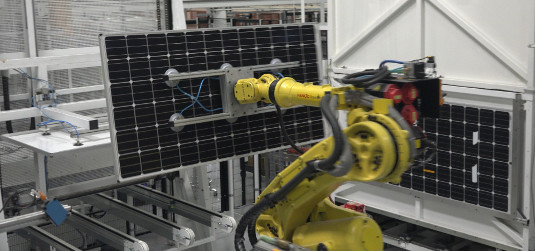Over the last few weeks, SolarWorld Americas has ramped production of a new 72-cell PV module line at its fully automated cell and module facility in Hillsboro, Oregon, as revealed in a recent visit by pv magazine staff.
The line has an annual capacity of 150 MW, and combined with existing 60-cell lines the factory now has the capacity to produce 550 MW of PV modules annually. This makes SolarWorld’s Oregon facility the largest crystalline silicon PV module factory in the Western Hemisphere, and including German production SolarWorld has reached 1.5 GW cell and module capacity globally.
This also places the Hillsboro plant not far behind First Solar’s 640 MW of thin-film module capacity in Ohio. SolarWorld notes that it has space to add another 100 MW of production in Oregon module facility.
SolarWorld says that it has seen increased demand for 72-cell modules from its installers for commercial- and utility-scale projects, and additionally solar installers at SolarWorld’s recent Installer Summit report demand in the residential segment for the larger, higher-powered modules, which have power ratings up to 350 watts.
In addition to the new module capacity, SolarWorld has 430 MW of annual cell capacity in Hillsboro, and began production of 5-busbar PV cells on some lines earlier this spring. In an interview with pv magazine, SolarWorld Americas VP of Operations Steve Pecis notes that the five busbars enable both a more robust connection between cells and better evacuation of power, leading to 2% greater power output.
SolarWorld is currently producing 5-busbar, 60-cell PV modules with power ratings up to 300 watts. While modules featuring 4 busbars have been produced by multiple PV makers, these are the first 5-busbar PV modules observed by pv magazine staff.
In the future SolarWorld plans to spread the 5-busbar design across all of its cell lines. Assuming board approval, the company plans to begin production of 5-busbar, 72-cell modules in the first quarter of 2017.
Other notable aspects of SolarWorld’s production are that all cells made in the factory utilize passivated emitter rear contact (PERC) technology, and the high degree of automation throughout. No manual steps were observed by pv magazine staff on either the cell or module lines, which included automated induction welding of electrical connections.
Finally, the company has resumed production of monocrystalline silicon ingots at the factory. While only a portion of the company’s ingot furnaces are currently in production, the facility has the capacity to produce sufficient ingots to supply 250 MW of PV cells annually.
Wafer production is still idle at Hillsboro, meaning that the factory is exporting ingots and importing wafers from SolarWorld’s German production.
View the full interview with SolarWorld Americas VP of Operations Steve Pecis:
This content is protected by copyright and may not be reused. If you want to cooperate with us and would like to reuse some of our content, please contact: editors@pv-magazine.com.









1 comment
By submitting this form you agree to pv magazine using your data for the purposes of publishing your comment.
Your personal data will only be disclosed or otherwise transmitted to third parties for the purposes of spam filtering or if this is necessary for technical maintenance of the website. Any other transfer to third parties will not take place unless this is justified on the basis of applicable data protection regulations or if pv magazine is legally obliged to do so.
You may revoke this consent at any time with effect for the future, in which case your personal data will be deleted immediately. Otherwise, your data will be deleted if pv magazine has processed your request or the purpose of data storage is fulfilled.
Further information on data privacy can be found in our Data Protection Policy.